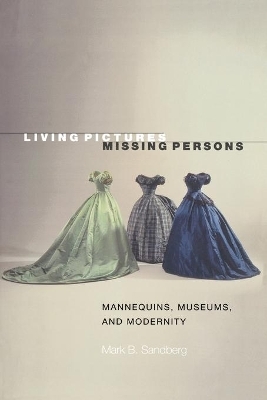
Living Pictures, Missing Persons
Princeton University Press (Verlag)
978-0-691-05074-4 (ISBN)
In the late nineteenth century, Scandinavian urban dwellers developed a passion for a new, utterly modern sort of visual spectacle: objects and effigies brought to life in astonishingly detailed, realistic scenes. The period 1880-1910 was the popular high point of mannequin display in Europe. Living Pictures, Missing Persons explores this phenomenon as it unfolded with the rise of wax museums and folk museums in the largest cities of Denmark, Sweden, and Norway. Mark Sandberg asks: Why did modernity generate a cultural fascination with the idea of effigy? He shows that the idea of effigy is also a portal to understanding other aspects of visual entertainment in that period, including the widespread interest in illusionistic scenes and tableaux, in the "portability" of sights, spaces, and entire milieus. Sandberg investigates this transformation of visual culture outside the usual test cases of the largest European metropolises. He argues that Scandinavian spectators desired an unusual degree of authenticity--a cultural preference for naturalism that made its way beyond theater to popular forms of museum display.
The Scandinavian wax museums and folk-ethnographic displays of the era helped pre-cinematic spectators work out the social implications of both voyeuristic and immersive display techniques. This careful study thus anticipates some of the central paradoxes of twentieth-century visual culture--but in a time when the mannequin and the physical relic reigned supreme, and in a place where the contrast between tradition and modernity was a high-stakes game.
Mark B. Sandberg is Associate Professor of Scandinavian and Film Studies at the University of California, Berkeley.
LIST OF ILLUSTRATIONS vii ACKNOWLEDGMENTS xiii CHAPTER ONE: The Idea of Effigy 1 CHAPTER TWO: Upstairs, Downstairs at the Wax Museum 18 A Scandinavian Panoptikon 26 Ape in the Human 29 CHAPTER THREE: The Wax Effigy as Recording Technology 37 Annihilation of Space and Time 40 Effigy as Index 47 Persuasive Relics 59 CHAPTER FOUR: Figure and Tableau 69 Showing Stories 71 The Living Tableau 82 Toeing the Line 95 Entrapment Scenarios 108 CHAPTER FIVE: Panoptikon, Metropolis, and the Urban Uncanny 117 Small Big Cities 119 Urbanity and Orientalism 126 The City in the Mirror 135 CHAPTER SIX: Vanishing Culture 145 Cultural Juxtaposition 153 Tableaux for Tourists 161 Cradle or Grave? 168 CHAPTER SEVEN: Dead Bones Rise 178 Homeless Objects 182 Props 191 CHAPTER EIGHT: Insiders 202 Cohabitation 208 Traces 216 Home, Again 224 CHAPTER NINE: Farmers and Flaneurs 232 Cultural-Historical Intoxication 238 Goldi-Locks 245 Rubes and Gypsies 250 Greater Skansen 255 CHAPTER TEN: Material Mobility 261 NOTES 275
| Erscheint lt. Verlag | 8.12.2002 |
|---|---|
| Zusatzinfo | 77 halftones. |
| Verlagsort | New Jersey |
| Sprache | englisch |
| Maße | 152 x 235 mm |
| Gewicht | 482 g |
| Themenwelt | Kunst / Musik / Theater ► Theater / Ballett |
| Geisteswissenschaften ► Geschichte ► Hilfswissenschaften | |
| Sozialwissenschaften | |
| ISBN-10 | 0-691-05074-0 / 0691050740 |
| ISBN-13 | 978-0-691-05074-4 / 9780691050744 |
| Zustand | Neuware |
| Informationen gemäß Produktsicherheitsverordnung (GPSR) | |
| Haben Sie eine Frage zum Produkt? |
aus dem Bereich


